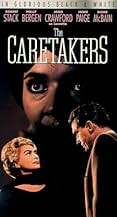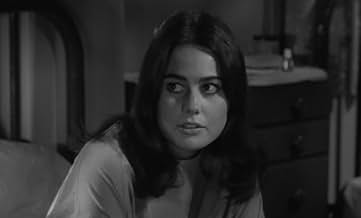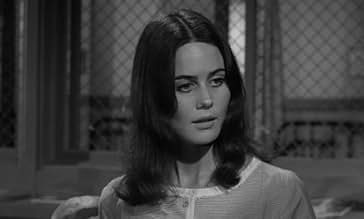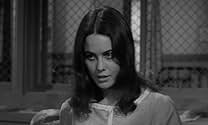Medical drama about mentally-ill patients and their professional caregivers, as well as the new group-therapy sessions aiming to replace the traditional physical restraint and electroshock t... Read allMedical drama about mentally-ill patients and their professional caregivers, as well as the new group-therapy sessions aiming to replace the traditional physical restraint and electroshock treatments.Medical drama about mentally-ill patients and their professional caregivers, as well as the new group-therapy sessions aiming to replace the traditional physical restraint and electroshock treatments.
- Nominated for 1 Oscar
- 5 nominations total
Ana María Lynch
- Ana
- (as Ana St. Clair)
Pamela Austin
- Student Nurse
- (uncredited)
Brian Corcoran
- Tony
- (uncredited)
George DeNormand
- Doctor
- (uncredited)
Featured reviews
I find this one of the most difficult films of its era to sit through; it is truly nerve-bending, asinine, and infuriating. if you look upon it as camp, it still is difficult to take unless you like the sight of bizarre creature polly bergen constantly throwing fits and screaming (it's truly horrific) and can tolerate the posturing hero and a story and scenes which purport to shed light on mental illness but is totally phony in every particular. diane mcbain is gorgeous and smug; joan crawford and constance ford as butch as they come; janis paige gives the most enjoyable performance in the film, or at least creates a somewhat believable character till she phonies out toward the end. it's pathetic that maltin and others would even consider taking this film seriously. it is a fairy tale put together by fly-by-night producers for a quick buck who wanted to make it look like one of those 50's/early 60's "message" social reform pictures, and people were dumb enough to accept that.
Yes - I've read other critiques posted here. A large consensus focus on THE CARETAKERS being a poor-man's THE SNAKE PIT. Others focus on Joan Crawford being, well - Joan Crawford.
Yes, you can go on about both of those, but I'd like to take a different tact.
First, let me say this film is NOT a 'Grand-Guignol' picture of the era, a 'la WHATEVER HAPPENED TO BABY JANE, or HUSH, HUSH SWEET CHARLOTTE, which several people commenting have alluded it might be, give the fact that Joan Crawford is in it, and this WAS made at that time.
I'd like to start off by saying THE CARETAKERS is an entertaining film, with some fine performances by many familiar faces, amongst them are Robert Vaughn (THE MAN FROM U.N.C.L.E.), Van Willaims (GREEN HORNET), Janis Page, Barbara Barrie, Ellen Corby (THE WALTONS, and my personal favourite - Susan Oliver (THE CAGE - STAR TREK: TOS) and more.
While THE CARETAKERS does come across as a 'message' film, and given the time does seem somewhat campy, some of the treatment ideas proposed for the patients were - at the time - considered radical. Polly Bergen whose character Lorna introduces us to the film (having a breakdown at a packed movie theatre)must've really spent a good amount of time doing research. When Polly's character gets E.C.T., (electroconvulsive therapy - or, as it was better known then SHOCK THERAPY) she twists, pulls. Susan Oliver as the young nurse in training is very uneasy during this, and so was I.
Yes - some of the film does draw comparisons to better known films, but, I think that the film tries to give what was at the time - an 'honest' portrayal of a psychiatric hospital, and the (modern) changes that were taking place at that time - their effect on the doctors and nurses who both administered these treatments, and the effect these treatments had on a group of patients.
If the cast was less professional, it could've easily veered into farce, but given the talent, THE CARETAKERS is an engrossing, if a bit 'soapish' film.
Yes, you can go on about both of those, but I'd like to take a different tact.
First, let me say this film is NOT a 'Grand-Guignol' picture of the era, a 'la WHATEVER HAPPENED TO BABY JANE, or HUSH, HUSH SWEET CHARLOTTE, which several people commenting have alluded it might be, give the fact that Joan Crawford is in it, and this WAS made at that time.
I'd like to start off by saying THE CARETAKERS is an entertaining film, with some fine performances by many familiar faces, amongst them are Robert Vaughn (THE MAN FROM U.N.C.L.E.), Van Willaims (GREEN HORNET), Janis Page, Barbara Barrie, Ellen Corby (THE WALTONS, and my personal favourite - Susan Oliver (THE CAGE - STAR TREK: TOS) and more.
While THE CARETAKERS does come across as a 'message' film, and given the time does seem somewhat campy, some of the treatment ideas proposed for the patients were - at the time - considered radical. Polly Bergen whose character Lorna introduces us to the film (having a breakdown at a packed movie theatre)must've really spent a good amount of time doing research. When Polly's character gets E.C.T., (electroconvulsive therapy - or, as it was better known then SHOCK THERAPY) she twists, pulls. Susan Oliver as the young nurse in training is very uneasy during this, and so was I.
Yes - some of the film does draw comparisons to better known films, but, I think that the film tries to give what was at the time - an 'honest' portrayal of a psychiatric hospital, and the (modern) changes that were taking place at that time - their effect on the doctors and nurses who both administered these treatments, and the effect these treatments had on a group of patients.
If the cast was less professional, it could've easily veered into farce, but given the talent, THE CARETAKERS is an engrossing, if a bit 'soapish' film.
Sixteen years after The Snake Pit and 13 years before One Flew Over The Cuckoo's Nest, The Caretakers joins their company as `enlightened' explorations of the mentally ill and the institutions that hold them. But The Caretakers stays closer in spirit to Caged, with the female inmates transferred from the Big House to a mental ward called (of all things!) Borderline. (There's actually one holdover from the cast of Caged Ellen Corby, as a batty old schoolmarm and one sequence involving a parakeet which almost exactly reprises one involving a cat in the earlier movie.) But while Caged was overwrought but compellingly good, The Caretakers is overwrought and compellingly bad.
The jangly piano music over the titles, with their suggestions of Di Chirico and Picasso's `Guernica,' clue us to the racheted-up, `serious' tone of the movie. But soon we're watching Polly Bergen go flat-out berserk in front of the screen of a crowded theater. An ambulance ushers her into the gloomy shadows (the movie is well photographed) of the mental hospital, where she comes under the care of Robert Stack, who is pioneering progressive and humane methods of treatment (which nonetheless require jolts of electricity to the temples).
But Bergen is but one of the woeful women among whom we divide our time. This is the kind of dramaturgy where, when Barbara Barrie is introduced as never having uttered a word in seven years, we wait 90 minutes with bated breath for her to speak. She's lucky to get a word in edgewise, as recovering prostitute Janis Paige bazoos her way through every scene she's in and steals all the thunder from Bergen's go-for-broke histrionics.
The staff faces its own problems, however. Head of the hospital is Herbert Marshall, looking like he was just trundled in from Madame Tussaud's, but he's just a figurehead who has long since ceded authority to underlings, particularly Joan Crawford. Since she's been saddled with the name Lucretia, with nasty echoes of the Borgias, we know she's not exactly a helping professional. She stands in adamant opposition to everything Stack works for, and relies on head nurse and hard case Constance Ford as her secret agent. Unfortunately, Crawford's role is smaller than we can be sure she hoped it would be (and often her position seems to make sense).
That's about it. We never get to see a promised, climactic board meeting which will decide the fates of Crawford and Stack. That may have been a try for ironic ambiguity, but it looks like the movie just ran out of steam, or money. For some of the patients, rays of hope do pop out of the institutional-grey skies, for Hollywood never acknowledged a problem that couldn't be wrapped up by the last reel. This mixture of high earnestness and wretched overacting is simply stupefying.
The jangly piano music over the titles, with their suggestions of Di Chirico and Picasso's `Guernica,' clue us to the racheted-up, `serious' tone of the movie. But soon we're watching Polly Bergen go flat-out berserk in front of the screen of a crowded theater. An ambulance ushers her into the gloomy shadows (the movie is well photographed) of the mental hospital, where she comes under the care of Robert Stack, who is pioneering progressive and humane methods of treatment (which nonetheless require jolts of electricity to the temples).
But Bergen is but one of the woeful women among whom we divide our time. This is the kind of dramaturgy where, when Barbara Barrie is introduced as never having uttered a word in seven years, we wait 90 minutes with bated breath for her to speak. She's lucky to get a word in edgewise, as recovering prostitute Janis Paige bazoos her way through every scene she's in and steals all the thunder from Bergen's go-for-broke histrionics.
The staff faces its own problems, however. Head of the hospital is Herbert Marshall, looking like he was just trundled in from Madame Tussaud's, but he's just a figurehead who has long since ceded authority to underlings, particularly Joan Crawford. Since she's been saddled with the name Lucretia, with nasty echoes of the Borgias, we know she's not exactly a helping professional. She stands in adamant opposition to everything Stack works for, and relies on head nurse and hard case Constance Ford as her secret agent. Unfortunately, Crawford's role is smaller than we can be sure she hoped it would be (and often her position seems to make sense).
That's about it. We never get to see a promised, climactic board meeting which will decide the fates of Crawford and Stack. That may have been a try for ironic ambiguity, but it looks like the movie just ran out of steam, or money. For some of the patients, rays of hope do pop out of the institutional-grey skies, for Hollywood never acknowledged a problem that couldn't be wrapped up by the last reel. This mixture of high earnestness and wretched overacting is simply stupefying.
The Caretakers (1963)
It's hard to imagine actually going to the movie to see this movie as a kind of entertainment, because it is more an experience and an emotional plea than a good idea for a first date. There's no question it's powerful, sometimes disturbing, and acted and filmed with intensity. It is, in its own way, a great movie, if you measure it only in terms of being moved. It is also a questionable movie in how it portrays these women, all of whom are "borderline" cases, and none of whom are openly diagnosed for us. Still, some of the most radical behavior is stuff I've seen first hand, and so it isn't completely unreasonable.
The big theme is interesting to see in retrospect: this seems to be about the very first shifts from large hospital care of the mentally troubled to residential care. The key to this is the notion that the patients (they call them "consumers" now) can form small, interactive "families" that encourage emotional and psychological support. It's a kind of giant co-counselling, and I think it's been shown to work in the fifty years since.
There are several equally strong characters as the plot follows one and then another, from patient to nurse to doctor. Joan Crawford gives a steely, power-performance as the head nurse, though only now and then. Herbert Marshall briefly appears as an aging, wise figure in his second to last film. The rest of the cast is made of lesser known actresses who act out the different characters of this woman's ward with disarming conviction (or theatricality, if you don't buy into their illnesses). The lead doctor is played by Robert Stack who never strikes me as quite up to any acting task, but then he's just a figurehead of authority and progress. The movie is in the hands of the women.
Director Hall Bartlett doesn't have much of a career as director, but he's managed to get a terrific cinematographer, Lucian Ballard, to make it a visually brooding and beautiful experience. And the music is by one of the best, Elmer Bernstein. The copy of the movie that streams on netflix has a flaw in the sound which was unfortunate--the quiet portions, including some important conversations, were very quiet, and then when the music and screaming explodes in other scenes it'll hurt your ears. Very very loud. It made for a clumsy viewing, moving the volume up and down, backtracking now and then to see what we missed.
Expect to be impressed and moved and possibly slightly shocked. Overlook some of the neatened up psychology that is a product of both the era and the era the movie was made. And don't look for a surprising plot. Instead you'll get to know a few of the women and when it gets to the final scenes it'll be moving and even a little joyous. If you let it.
It's hard to imagine actually going to the movie to see this movie as a kind of entertainment, because it is more an experience and an emotional plea than a good idea for a first date. There's no question it's powerful, sometimes disturbing, and acted and filmed with intensity. It is, in its own way, a great movie, if you measure it only in terms of being moved. It is also a questionable movie in how it portrays these women, all of whom are "borderline" cases, and none of whom are openly diagnosed for us. Still, some of the most radical behavior is stuff I've seen first hand, and so it isn't completely unreasonable.
The big theme is interesting to see in retrospect: this seems to be about the very first shifts from large hospital care of the mentally troubled to residential care. The key to this is the notion that the patients (they call them "consumers" now) can form small, interactive "families" that encourage emotional and psychological support. It's a kind of giant co-counselling, and I think it's been shown to work in the fifty years since.
There are several equally strong characters as the plot follows one and then another, from patient to nurse to doctor. Joan Crawford gives a steely, power-performance as the head nurse, though only now and then. Herbert Marshall briefly appears as an aging, wise figure in his second to last film. The rest of the cast is made of lesser known actresses who act out the different characters of this woman's ward with disarming conviction (or theatricality, if you don't buy into their illnesses). The lead doctor is played by Robert Stack who never strikes me as quite up to any acting task, but then he's just a figurehead of authority and progress. The movie is in the hands of the women.
Director Hall Bartlett doesn't have much of a career as director, but he's managed to get a terrific cinematographer, Lucian Ballard, to make it a visually brooding and beautiful experience. And the music is by one of the best, Elmer Bernstein. The copy of the movie that streams on netflix has a flaw in the sound which was unfortunate--the quiet portions, including some important conversations, were very quiet, and then when the music and screaming explodes in other scenes it'll hurt your ears. Very very loud. It made for a clumsy viewing, moving the volume up and down, backtracking now and then to see what we missed.
Expect to be impressed and moved and possibly slightly shocked. Overlook some of the neatened up psychology that is a product of both the era and the era the movie was made. And don't look for a surprising plot. Instead you'll get to know a few of the women and when it gets to the final scenes it'll be moving and even a little joyous. If you let it.
Ah, crazy people movies. Nothing actors like better than free range to ham it up under the guise of being insane. You know what's really sad? Fifty years later and the portrayal of mentally ill people in movies really hasn't changed much. Anyway, this movie is a drama about the goings-on at a hospital mental ward. In particular doctor Robert Stack, who tackles his greatest "unsolved mystery" in this film: Joan Crawford. Joan plays a hard-nosed head nurse named Lucretia who doesn't like softie Stack's approach to dealing with the loonies. Dated and often silly, it can be a tough slog to sit through. But whenever Joan's on screen, things are more interesting. Seeing Joan in a leotard teaching her nurses self-defense is a must for every Joan fan! I see several reviews comparing this to The Snake Pit, which I find ridiculous. The Snake Pit was a million times better than this. This is a forgettable drama with good intentions that is only memorable for Joan Crawford's supporting part.
Did you know
- TriviaJoan Crawford went out of her way to help an aging Herbert Marshall with his lines. She also arranged to have his scenes filmed first so he could leave the set early in the day as he was an old friend and in ill health.
- GoofsAs Lorna runs into the hospital, there's nothing outside the door. But the shot from inside shows a small wall just outside the door which she would have had to jump over or go around to enter.
- Quotes
Dr. Donovan MacLeod: Truth Marion, that's all we're looking for.
- ConnectionsFeatured in Hollywood: The Great Stars (1963)
Details
Box office
- Gross US & Canada
- $2,050,000
- Gross worldwide
- $3,160,000
- Runtime
- 1h 37m(97 min)
- Color
- Aspect ratio
- 1.66 : 1
Contribute to this page
Suggest an edit or add missing content



































